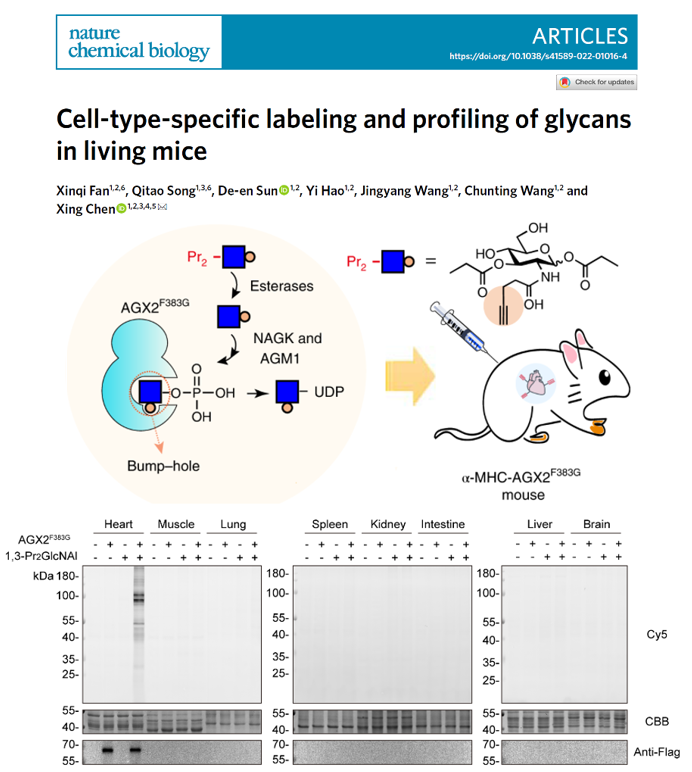Prof. Chen Xing’s Group Developed a Tool for Cell-Type-Specific Labeling of Glycans in Living Mice
May 24, 2022
Peking University, May 24, 2022: Metabolic glycans labeling (MGL) offers a powerful means to study glycans in multicellular systems. It utilized unnatural sugars (for example, azidosugars or alkynyl sugars) which are metabolically incorporated into cellular glycans followed by bioorthogonal conjugation with functional probes such as fluorophores and affinity tags. However, cell-type-specific labeling of glycans in vivo remains challenging. Strategies for cell-type-specific and tissue-specific labeling and profiling of glycans in vivo are of great importance to the precise understanding of glycans which exhibit the great diversity between tissues and cells.
Prof. Chen Xing’s Group at the College of Chemistry and Molecular Engineering and Center for Life Sciences, Peking University, reported genetically encoded MGL (GeMGL), which leverages the bump-and-hole approach for an orthogonal engineered enzyme–unnatural sugar pair, providing binary stringency for cell-specific glycan labeling in live cells and living mice. N-pentynylacetylglucosamine (GlcNAl) containing a linear propargyl group as the bump was paired with a mutant form of UDP-GlcNAc pyrophosphorylase, AGX2F383G, for specific incorporation into glycans of cells expressing AGX2F383G.
The GeMGL strategy was demonstrated in multicellular co-culture systems and mouse transplant tumor models. In cell cocultures, only the cells expressing AGX2F383G were metabolically labeled with 1,3-O-propionyl-GlcNAl (1,3-Pr2GlcNAl), a partially acylated GlcNAl with improved labeling efficiency. Furthermore, glycans in tumors expressing AGX2F383G were specifically labeled in a xenograft mouse model.
This strategy was applied to a transgenic mouse line with the cardiomyocyte-specific expression of AGX2F383G under the α-myosin heavy chain (α-MHC) promoter, in which 1,3-Pr2GlcNAl specifically labeled glycans in cardiomyocytes with alkynes. Click labeling with fluorophores and affinity tags enabled specific imaging of cardiomyocyte glycans and identification of 582 O-GlcNAcylated proteins from cardiomyocytes, respectively. The GeMGL-identified O-GlcNAcylated proteins include a large portion of the enzymes involved in the glycolysis, tricarboxylic acid (TCA) cycle and oxidative phosphorylation. GeMGL is promising to complete the cell-type-specific glycan atlas and to be further expanded for the profiling of glycans in specific types of neurons in vivo.

The research results were published in the journal Nature Chemical Biology, titled "Cell-type-specific labeling and profiling of glycans in living mice". Dr. Fan Xinqi and Dr. Song Qitao are the co-first authors of the paper. The research work was funded by the National Natural Science Foundation of China, the Ministry of Science and Technology, the Peking-Tsinghua Center for Life Sciences, and the Beijing National Laboratory for Molecular Sciences.
Original link for the paper: https://www.nature.com/articles/s41589-022-01016-4.
Edited by: Guo Xuke
